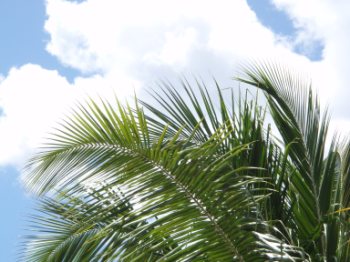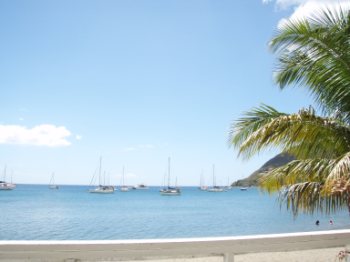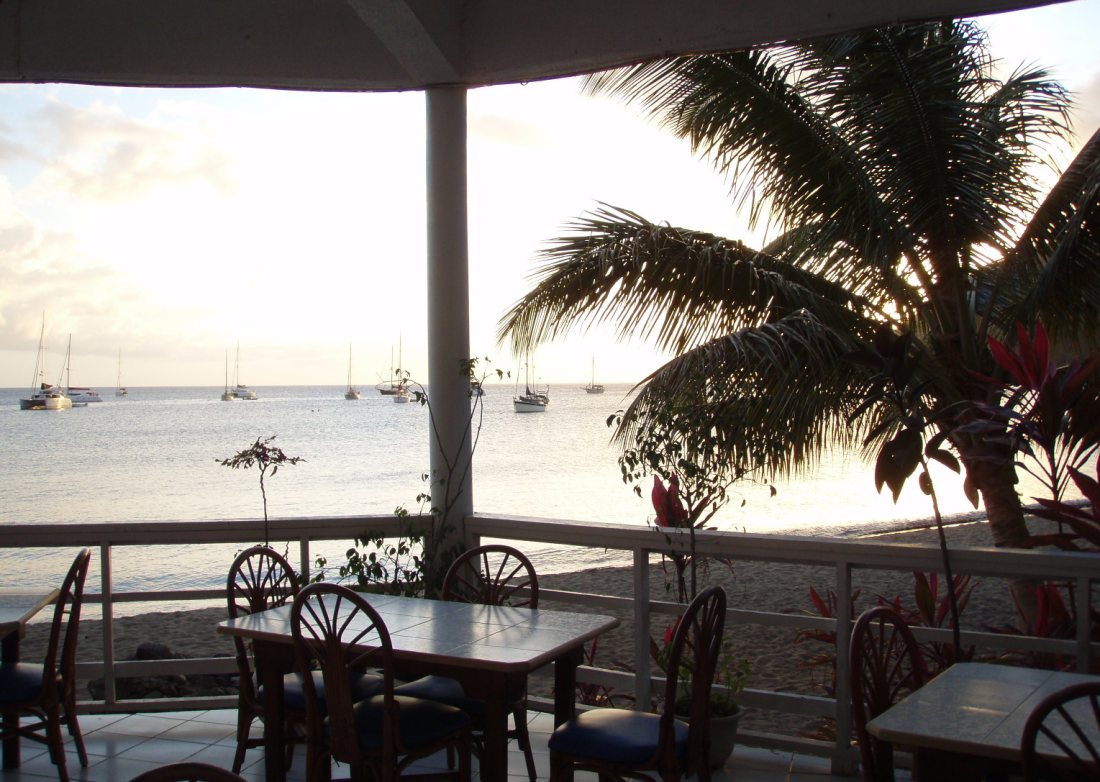|
The Coconut Palm
We went over to Cubrits National Park at the northern end of
the bay, it was too late to walk the trails so we wandered along the beach
there, completely alone, just the two of us. As the sun was setting we took the
dinghy over to The Purple Turtle for a beer before going for water down the
road. All through the day I found I had never been out of sight of a coconut
tree. I got to thinking about the humble Coconut Tree, we have grown used to
it as a familiar sight here in the Caribbean. The tree to everyone
immediately conjures up hundreds of images of sun, sea, balmy evenings, tropical
punch, steel bands and in general happy thoughts, including the rogue Hawaiian
shirt with the palm print lurking in the back of the wardrobe. So here is a
little about the tree itself and its uses other than in photography.
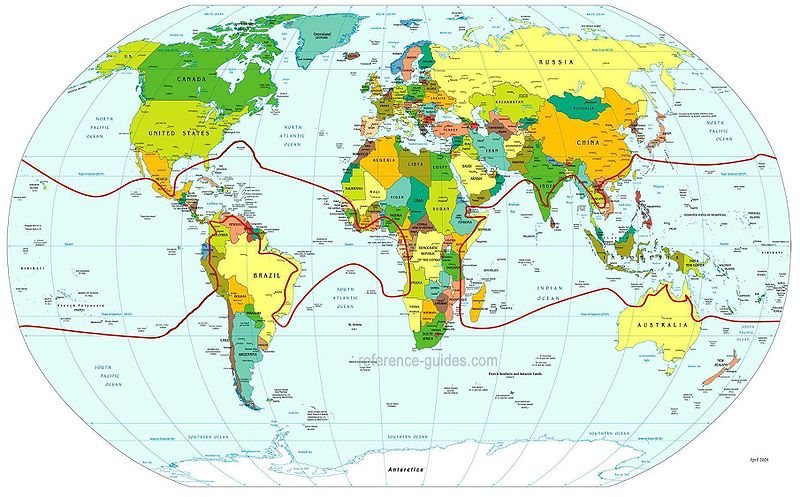
Where they grow
(Cocos
nucifera) is a member of the Family Arecaceae (palm family). It is the only species in the
genus Cocos, and is a large palm, growing to 30
metres tall, with pinnate leaves four to six metres in
length, pinnae sixty to ninety centimetres long; old leaves break away cleanly
leaving the trunk smooth. The term coconut refers
to the seed of the coconut palm. An alternate spelling is cocoanut. The coconut
palm is grown throughout the tropical world, for decoration as well
as for its many culinary and non-culinary uses; virtually every part of the
coconut palm has some human uses.The coconut has spread across much of the
tropics, probably aided in many cases by seafaring people. The fruit is light
and buoyant and presumably spread significant distances by marine currents.
Fruits collected from the sea as far north as Norway have been found to
be viable (and subsequently germinated under the right conditions). In the
Hawaiian Islands, the coconut is regarded as a
Polynesian introduction, first brought to
the islands by early Polynesian voyagers from their homelands in the South
Pacific. They are now almost ubiquitous between 26
degrees North and 26 degrees South. The flowers of the coconut palm are
polygamomonoecious, with both male and female
flowers in the same inflorescence. Flowering occurs continuously, with female
flowers producing seeds. Coconut palms are believed to be largely
cross-pollinated, although some dwarf varieties
are self-pollinating. Coconuts also come with a liquid that is clear like water
but sweet. The "Nut" of the coconut is edible and is in the shape of a ball or
is on the inside sides of the coconut.
  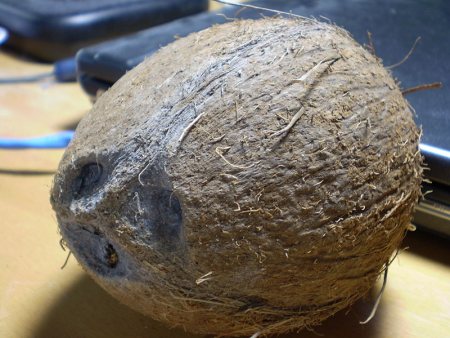
Uses
Nearly all parts of the coconut palm are useful, and the palms
have a comparatively high yield, up to 75 fruits per year; it therefore has
significant economic value. The name for
the coconut palm in Sanskrit is kalpa vriksha,
which translates as "the tree which provides all the necessities of life". In
Malay, the coconut is known as pokok seribu guna,
"the tree of a thousand uses". In the Philippines, the coconut is commonly given the title "Tree of
Life".
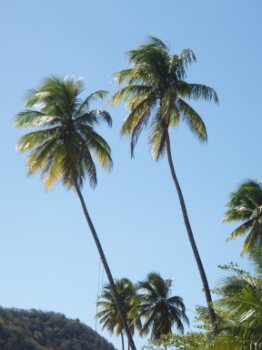 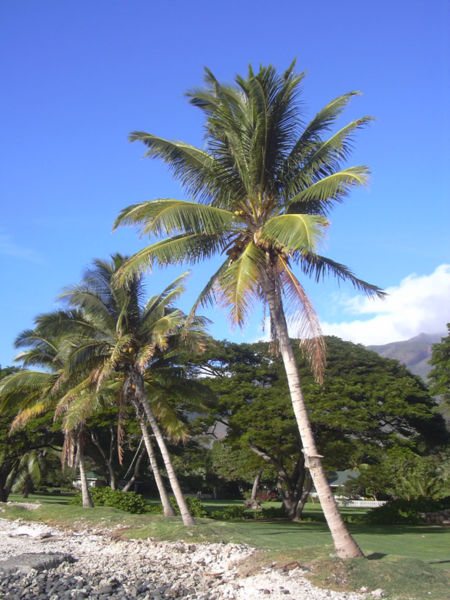 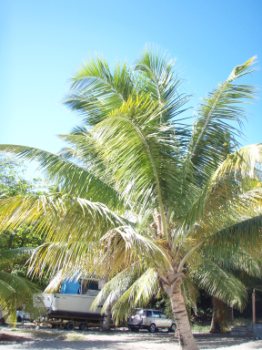
Culinary
Culinary uses of the various parts of the palm include:
- The white, fleshy part of the seed, the coconut meat, is edible and used fresh or dried
in cooking.
- Sport fruits are also
harvested, primarily in the Philippines, where they are known as macapuno.
They are sold in jars as "gelatinous mutant coconut" cut into balls or
strands.
- The cavity is filled with coconut water
which contains sugar, fibre, proteins, antioxidants, vitamins and minerals. Coconut water provides an isotonic
electrolyte balance, and is a highly nutritious food source. It
is used as a refreshing drink throughout the humid tropics and is also used in
isotonic sports drinks. It can also be used to make the gelatinous dessert
nata de coco. Mature fruits have
significantly less liquid than young immature coconuts; barring spoilage,
coconut water is sterile until opened.
Coconut milk is made by processing grated
coconut with hot water or milk, which extracts the oil and aromatic compounds.
It should not be confused with the coconut water discussed above, and has a fat content of
approximately 17%. When refrigerated and left to set, coconut
cream will rise to the top and separate out the
milk. The milk is used to produce virgin coconut oil by controlled heating and
removing the oil fraction. Virgin coconut oil is found superior to the oil
extracted from copra for cosmetic purposes.
- The leftover fibre from coconut milk production is used as livestock feed.
- The smell of coconuts comes from the 6-pentyloxan-2-one
molecule, known as delta-decalactone in the
food and fragrance industry.
- The sap
derived from incising the
flower clusters of the coconut is drunk as neera, or fermented to produce palm
wine, also known as "toddy" or, in the
Philippines, tuba. The sap can also be reduced by boiling to create a sweet
syrup or candy.
Apical buds of adult plants are edible
and are known as "palm-cabbage" or heart-of-palm. It is considered a rare delicacy, as the act of
harvesting the bud kills the palm. Hearts of palm are eaten in salads,
sometimes called "millionaire's salad".
Ruku Raa is an extract from the young
bud, a very rare type of nectar collected and used as morning break drink in
the islands of Maldives reputed for its
energetic power keeping the "raamen" (nectar collector) healthy and fit even
over eighty and ninety years old. And by-products, a sweet honey-like syrup
called dhiyaa hakuru is used as a creamy sugar for desserts.
- Newly germinated coconuts contain an edible fluff of
marshmallow
-like consistency called
coconut sprout, produced as the endosperm
nourishes the developing embryo.
- In the Philippines, rice is wrapped in coco leaves for cooking and
subsequent storage - these packets are called puso
.
- In Vietnam
, coconut is grown in Ben Tre
Province - the "Land of coconut" and
people use it to make coconut candy, coconut caramel and mut dua. Coconut water and coconut milk is also put in many
dishes such as kho,
che, etc. especially in the Vietnam's Southern
style of cooking.
Non-culinary
- Coconut water can be used as an intravenous
fluid.
Coir (the fibre from the husk of
the coconut) is used in ropes, mats, brushes, caulking boats and as stuffing
fibre; it is also used extensively in horticulture for making potting compost.
Coconut oil can be rapidly processed and
extracted as a fully organic product from fresh coconut flesh, and used in
many ways including as a medicine and in cosmetics, or as a direct replacement for
diesel fuel.
Copra is the dried meat of the seed
and, after further processing, is a source of low grade coconut
oil.
- The leaves provide materials for baskets and roofing thatch.
Palm Wood comes from the trunk and is
increasingly being used as an ecologically-sound substitute for endangered
hardwoods. It has several applications, particularly in
furniture and specialized construction
(notably in Manila's Coconut
Palace).
- Hawaiians hollowed the trunk to form drums, containers, or even small
canoes.
- The husk and shells can be used for fuel and are a good source of
charcoal
.
- Dried half coconut shells with husks are used to buff floors. In the
Philippines, it is known as "bunot", and in Jamaica it is simply called
"coconut brush"
- During the 1992 Barcelona Olympics, a large amount of coconut shells were
imported by Spain from Kerala, India, to serve ice-creams and snacks.
- Activated carbon manufactured from coconut shell is considered superior to
those obtained from other sources mainly because of small macropores structure
which renders it more effective for the adsorption of gas/vapor and for the
removal of colour, oxidants, impurities and odour of compounds.
-
A coconut (Sanskrit : narikela) is an essential element of several
rituals in
Hindu tradition and is often decorated with
bright metal foils and other symbols of auspiciousness. It is offered during
worship to a Hindu god or goddess. Irrespective of their religious
affiliation, fishermen of India often offer it to the rivers and seas in the
hopes of having bountiful catches. In Hindu wedding ceremonies, a coconut is
placed over the opening of a pot, representing a womb. Hindus often initiate the beginning of any new
activity by breaking a coconut to ensure the blessings of the gods and
successful completion of the activity. In tantric practices, coconuts are sometimes used as substitutes
for human skulls. The Hindu goddess of well-being and wealth,
Lakshmi, is often shown holding a
coconut - The Zulu Social Aid and Pleasure Club
of New Orleans traditionally throws hand decorated coconuts—the most
valuable of all Mardi Gras souvenirs—to parade revelers. The "Tramps" began
the tradition ca. 1901. In 1987 a "coconut law" was signed by Governor
Edwards exempting from insurance liability any decorated
coconut handed from a Zulu float.
- In the Philippines, dried half shells are used as a music instrument in a
folk dance called maglalatik, a traditional dance about the conflicts for
coconut meat within the Spanish era
- Shirt buttons can be carved out of dried coconut shell. Coconut buttons
are often used for Hawaiian Aloha shirts
.
- The stiff leaflet midribs can be used to make cooking skewers, kindling
arrows, or are bound into bundles, brooms and brushes.
- The roots
are used as a
dye, a mouthwash, and a medicine for
dysentery. A frayed-out piece of root
can also be used as a toothbrush.
- Half coconut shells are used in theatre Foley sound
effects
work, banged together to create the sound effect of a
horse's hoof beats. They were used in this way
in the Monty Python film Monty Python
and the Holy Grail.
- The
coconut tree was in every newspaper on the planet when Keith Richards - The
Rolling Stone - fell out of one.
- The leaves can be woven to create effective roofing materials, or reed
mats
.
- Half coconut shells may be deployed as an improvised bra, especially for
comedic effect or theatrical purposes. They were used in this way in the
1970's UK sitcom It Ain't Half Hot Mum
for example.
- Drained coconuts can be filled with gunpowder
and used as improvised explosive
devices.
- In fairgrounds
, a "coconut
shy" is a popular target practice game, and
coconuts are commonly given as prizes.
- A coconut can be hollowed out and used as a home for a rodent or small
bird. Halved, drained coconuts can also be hung up as bird feeders, and after
the flesh has gone, can be filled with fat in winter to attract
tits
.
- Fresh inner coconut husk can be rubbed on the lens of snorkeling goggles
to prevent fogging during use.
- Dried coconut leaves can be burned to ash, which can be harvested for
lime
.
- Coconuts can be used as ammunition for homemade
catapults
.
- Dried half coconut shells are used as the bodies of musical instruments,
including the Chinese yehu
and
banhu, and the Vietnamese dan
gao.
- Coconut is also commonly used as a traditional remedy in
Pakistan to treat bites from rats.
- The "branches" (leaf petioles) are strong and flexible enough to make a
switch
. The use of coconut branches in corporal
punishment was revived in the Gilbertese community on Choiseul in the Soloman
Islands in
2005.
- In World War II
, coast
watcher scout Biuki
Gasa was the first of two from the Soloman
Islands to reach the shipwrecked,
wounded, and exhausted crew of Motot Torpedo Boat
PT-109 commanded by future U.S. president John F.
Kennedy. Gasa suggested, for lack of
paper, delivering by dugout canoe a message inscribed on a husked coconut
shell. This coconut was later kept on the president's desk, and is now in the
John F. Kennedy Library.
- Coconut trunks are used for building small bridges, preferred for their
straightness, strength and salt resistance
- Coconut shells are used to make coconut jewellery
.
- In Dominica there is still a small factory making suntan lotion, skin
lotion, candles and oil for cooking. The locals use the brown fibres to make
the hair for traditional dolls sold to tourists, the stick that holds the
fruit makes a good broom handle, they are proud to use every bit of the
coconut tree.
ALL IN ALL a really useful tree
that I will continue to use as a backdrop to good photographs whilst in the
Caribbean
|








